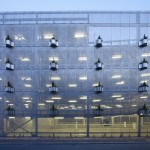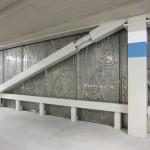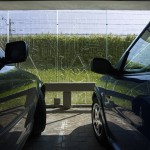The work of Dutch office mei is smart and complex. While their buildings immediately attract attention, they also spring from a deep reflection on programming and identity, urban life and the need of communities
Metaphorical greenery shapes the experimental facade of this garage. A project about public character for an equipment, architectural joy and hi-tech manufacturing
Text: Mei
Photo: Jeroen Musch, Mei
The place and the building.
The development of the Gnome parking garage, with 413 parking spaces, is part of the expansion of the city centre of Almere-Buiten. Features of this plan are a lot of green and a clear urban structure. All new buildings in Almere Buiten must convey this green character They usually do this with green roofs and terraces. While exploring this character, we came across front gardens with gnomes and windmills, and fringes of reeds in the surrounding polders, and birdhouses in municipal trees. And since the green is not always present in the winter, we decided in consultation with the client (the municipality of Almere) to cover the car park with figuration depicting the everyday greenery of Almere Buiten. Such a lavishly adorned building seldom appears nowadays, and in Almere Buiten the building looks like an old-fashioned tin tobacco box between the flat brick and rubble walls that are common there. The figuration and narrative skin make this a welcome change in the somewhat dreary centre of Almere Buiten.
There is also literal nature – the special facade integrates plant containers with specific plants, choosen accordingly to the orientation of the facade.
Craftsmanship and production.
The Voest Alpine automotive company in Spakenburg, previously known as Polynorm, made the stainless-steel panels. Polynorm used to fabricate steel doorframes and is known, amongst other things, for the prefab steel houses from the 1960s. Since the take-over in about 1990, the company has mainly manufactured steel panelling for cars. Together with Atto Harsta of Aldus Bouwinnovatie we succeeded in stimulating some employees to produce the panels for the garage here. These panels are vacuum formed with the help of 3D computer techniques, special sheet-metal perforating machines, and moulds milled from cast steel. The small square perforations are specially rounded so that their corners of won’t tear when the sheets are being 3D vacuumed. Square-shaped perforations were chosen because the entire steel structure is composed of square tube profiles. Material development has therefore been conducted in almost molecular fashion, and the stainless-steel skin acquires a relation with the supporting steel structure. The delicacy of the material and its treatment with the accompanying production methods mark a return to the idea of crafted products in unique fashion.
Integration of building regulations in the panels.
The stainless-steel panels are designed in such a way that their air permeability is 30% on account of the ventilation requirements for car parks. They are also detailed for safety, in order to prevent people from falling through them, and are also almost entirely transparent during daylight from inside the garage and, as a result, ensure a socially safe space.
Coarse and fine detail.
As already stated, the garage is constructed entirely of square tube profiles. This is perhaps more expensive than IPE profiles but is better in terms of maintenance and sturdiness. The rough interior therefore contrasts sharply with the filigree veil that wraps the garage. This intentional contrast is best experienced at night. Moreover, the tender offer for the construction turned out to be 25% cheaper than expected.
A garage people will come to love.
Last but not least, the repetition of the ornamentation in combination with the different flower boxes results in a garage whose appearance has never been seen in the Netherlands before. It is no anonymous box of the sort we all know, but a garage we will come to love. It has already become a special place for the residents of Almere Buiten, even for graffiti-loving youths.
* Published in Zeppelin no. 110 / December 2012 – January 2013







